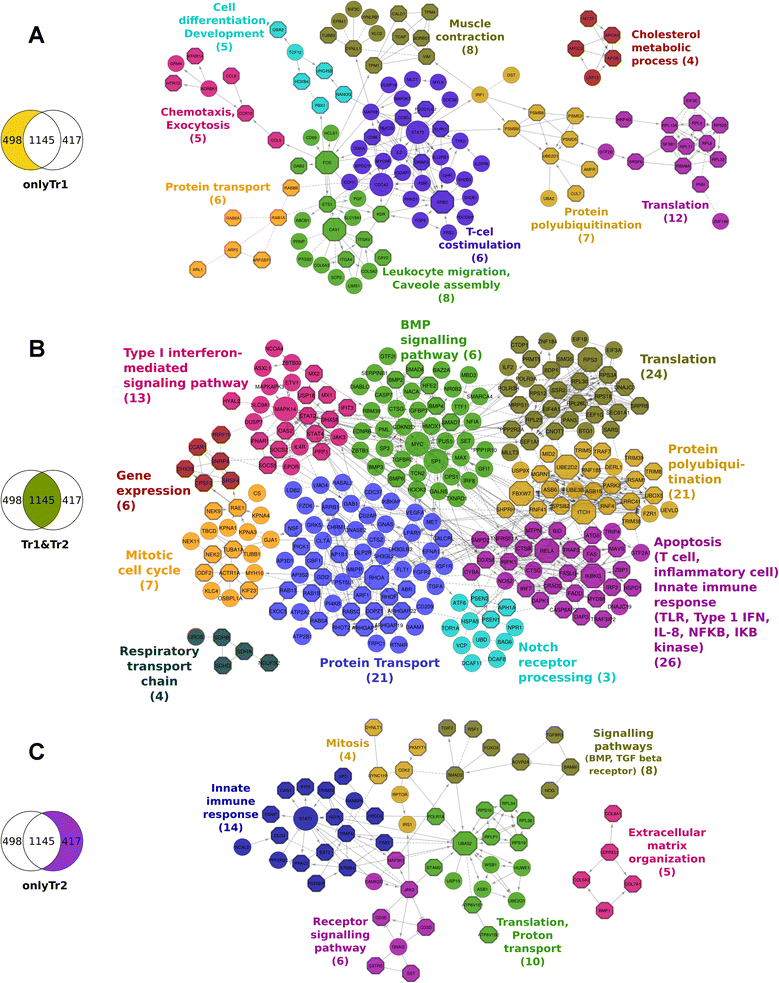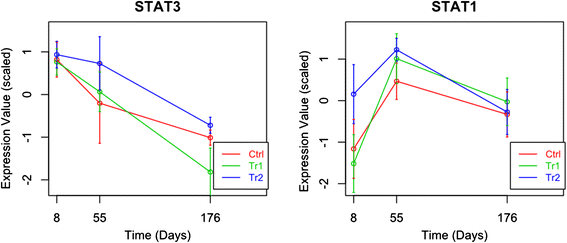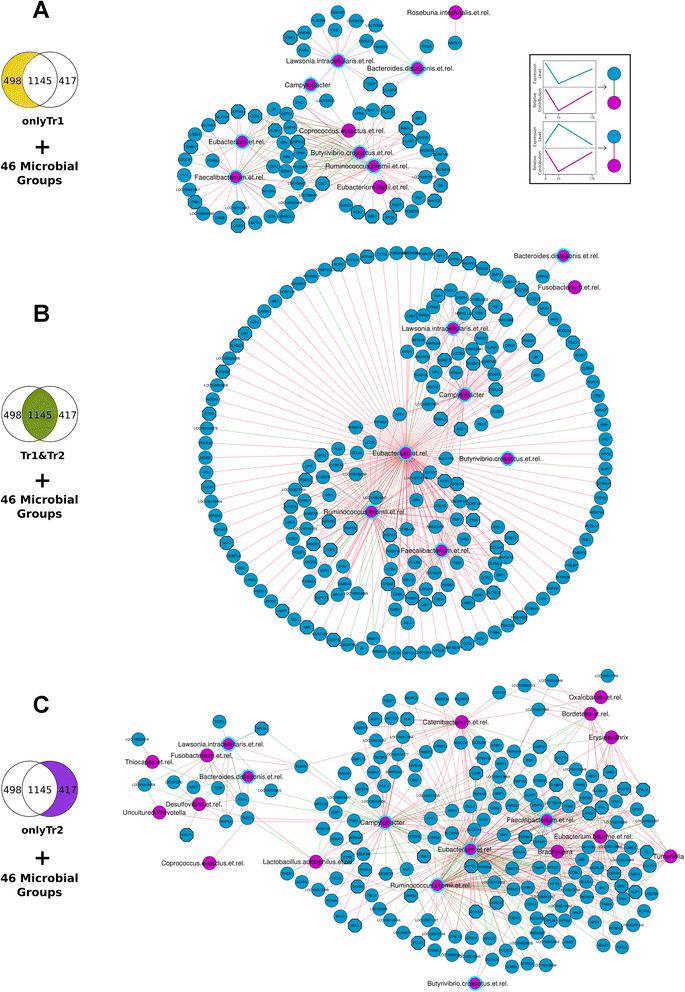Network analysis of temporal functionalities of the gut induced by perturbations in new-born piglets
- PMID: 26220188
- PMCID: PMC4518884
- DOI: 10.1186/s12864-015-1733-8
Network analysis of temporal functionalities of the gut induced by perturbations in new-born piglets
Abstract
Background: Evidence is accumulating that perturbation of early life microbial colonization of the gut induces long-lasting adverse health effects in individuals. Understanding the mechanisms behind these effects will facilitate modulation of intestinal health. The objective of this study was to identify biological processes involved in these long lasting effects and the (molecular) factors that regulate them. We used an antibiotic and the same antibiotic in combination with stress on piglets as an early life perturbation. Then we used host gene expression data from the gut (jejunum) tissue and community-scale analysis of gut microbiota from the same location of the gut, at three different time-points to gauge the reaction to the perturbation. We analysed the data by a new combination of existing tools. First, we analysed the data in two dimensions, treatment and time, with quadratic regression analysis. Then we applied network-based data integration approaches to find correlations between host gene expression and the resident microbial species.
Results: The use of a new combination of data analysis tools allowed us to identify significant long-lasting differences in jejunal gene expression patterns resulting from the early life perturbations. In addition, we were able to identify potential key gene regulators (hubs) for these long-lasting effects. Furthermore, data integration also showed that there are a handful of bacterial groups that were associated with temporal changes in gene expression.
Conclusion: The applied systems-biology approach allowed us to take the first steps in unravelling biological processes involved in long lasting effects in the gut due to early life perturbations. The observed data are consistent with the hypothesis that these long lasting effects are due to differences in the programming of the gut immune system as induced by the temporary early life changes in the composition and/or diversity of microbiota in the gut.
Figures




Similar articles
-
Long-lasting effects of early-life antibiotic treatment and routine animal handling on gut microbiota composition and immune system in pigs.PLoS One. 2015 Feb 6;10(2):e0116523. doi: 10.1371/journal.pone.0116523. eCollection 2015. PLoS One. 2015. PMID: 25658611 Free PMC article.
-
Restricting microbial exposure in early life negates the immune benefits associated with gut colonization in environments of high microbial diversity.PLoS One. 2011;6(12):e28279. doi: 10.1371/journal.pone.0028279. Epub 2011 Dec 22. PLoS One. 2011. PMID: 22216092 Free PMC article.
-
Jejunal inflammatory cytokines, barrier proteins and microbiome-metabolome responses to early supplementary feeding of Bamei suckling piglets.BMC Microbiol. 2020 Jun 17;20(1):169. doi: 10.1186/s12866-020-01847-y. BMC Microbiol. 2020. PMID: 32552686 Free PMC article.
-
Early-life environmental variation affects intestinal microbiota and immune development in new-born piglets.PLoS One. 2014 Jun 18;9(6):e100040. doi: 10.1371/journal.pone.0100040. eCollection 2014. PLoS One. 2014. PMID: 24941112 Free PMC article.
-
The pig gut microbial diversity: Understanding the pig gut microbial ecology through the next generation high throughput sequencing.Vet Microbiol. 2015 Jun 12;177(3-4):242-51. doi: 10.1016/j.vetmic.2015.03.014. Epub 2015 Mar 23. Vet Microbiol. 2015. PMID: 25843944 Review.
Cited by
-
Domestication Shapes the Community Structure and Functional Metagenomic Content of the Yak Fecal Microbiota.Front Microbiol. 2021 Mar 31;12:594075. doi: 10.3389/fmicb.2021.594075. eCollection 2021. Front Microbiol. 2021. PMID: 33897627 Free PMC article.
-
The effect of maternal antibiotic use in sows on intestinal development in offspring.J Anim Sci. 2020 Jun 1;98(6):skaa181. doi: 10.1093/jas/skaa181. J Anim Sci. 2020. PMID: 32479635 Free PMC article.
-
Multi-Level Integration of Environmentally Perturbed Internal Phenotypes Reveals Key Points of Connectivity between Them.Front Physiol. 2017 Jun 12;8:388. doi: 10.3389/fphys.2017.00388. eCollection 2017. Front Physiol. 2017. PMID: 28659815 Free PMC article.
-
Selectived and Reshaped Early Dominant Microbial Community in the Cecum With Similar Proportions and Better Homogenization and Species Diversity Due to Organic Acids as AGP Alternatives Mediate Their Effects on Broilers Growth.Front Microbiol. 2020 Jan 14;10:2948. doi: 10.3389/fmicb.2019.02948. eCollection 2019. Front Microbiol. 2020. PMID: 31993028 Free PMC article.
-
Neonatal and maternal dietary interventions driving microbiota and functionality in piglet gut compartments.Sci Rep. 2025 Feb 25;15(1):6771. doi: 10.1038/s41598-025-90781-y. Sci Rep. 2025. PMID: 40000703 Free PMC article.
References
-
- Foliaki S, Pearce N, Björkstén B, Mallol J, Montefort S, von Mutius E. Antibiotic use in infancy and symptoms of asthma, rhinoconjunctivitis, and eczema in children 6 and 7 years old: International Study of Asthma and Allergies in Childhood Phase III. J Allergy Clin Immunol. 2009;124:982–9. doi: 10.1016/j.jaci.2009.08.017. - DOI - PubMed
Publication types
MeSH terms
Substances
LinkOut - more resources
Full Text Sources
Other Literature Sources
Molecular Biology Databases

